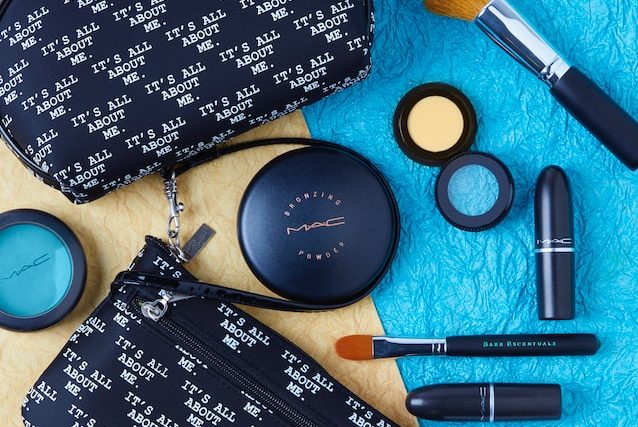Before we dive deep into the PESTEL analysis, let’s get the business overview of MAC cosmetics. MAC (Make-up Art Cosmetics) is a leading cosmetics brand known for its trendy makeup products, which fashion and entertainment industry professionals often use. The brand was founded in 1984 in Toronto, Canada, by Frank Toskan and Frank Angelo.
Product Line: MAC offers a comprehensive range of beauty products, including lipsticks, eyeshadows, foundations, mascaras, skincare products, and professional-grade makeup tools. The brand is renowned for its broad color palette, enabling users to find shades suitable for all skin tones.
Positioning: MAC stands out in the cosmetics industry because it is a brand for all ages, genders, and races. It emphasizes inclusivity, which resonates well with a diverse consumer base. The brand’s tagline, “All Ages, All Races, All Genders,” underscores this philosophy.
Collaborations and Limited-Edition Collections: MAC frequently collaborates with popular celebrities, artists, and designers to launch limited-edition collections. These collaborations often create buzz and attract customers looking for unique products.
Ownership: In 1994, The Estée Lauder Companies Inc. acquired MAC Cosmetics, further aiding its expansion and growth. Despite the acquisition, MAC retains a degree of independence within the Estée Lauder family of brands.
Celebrity Endorsements: MAC has always enjoyed strong ties with the entertainment industry. Numerous celebrities, including Lady Gaga, Rihanna, and Ariana Grande, have been MAC’s campaigns’ faces or collaborated for special product lines.
Here is the PESTEL analysis of MAC Cosmetics
A PESTEL analysis is a strategic management framework used to examine the external macro-environmental factors that can impact an organization or industry. The acronym PESTEL stands for:
- Political factors: Relate to government policies, regulations, political stability, and other political forces that may impact the business environment.
- Economic factors: Deal with economic conditions and trends affecting an organization’s operations, profitability, and growth.
- Sociocultural factors: Relate to social and cultural aspects that may influence consumer preferences, lifestyles, demographics, and market trends.
- Technological factors: Deal with developing and applying new technologies, innovations, and trends that can impact an industry or organization.
- Environmental factors: Relate to ecological and environmental concerns that may affect an organization’s operations and decision-making.
- Legal factors: Refer to the laws and regulations that govern businesses and industries.
In this article, we will do a PESTEL Analysis of MAC Cosmetics.
PESTEL Analysis Framework: Explained with Examples
Political
- Regulatory Environment: The cosmetics industry is subject to stringent regulations regarding product safety, ingredients, and labeling, especially in regions like the EU and the US. MAC must ensure its products meet these regulations to avoid legal complications and maintain its brand reputation.
- Animal Testing: Many countries, especially in the European Union, have banned animal testing for cosmetics. While MAC states that they do not test on animals and are committed to ending animal testing globally, the brand must navigate the challenges of selling in markets where animal testing is mandated by local regulations (such as China, though the rules are evolving).
- Intellectual Property Rights: Counterfeiting is a significant issue in the cosmetics industry. Political stability and strict regulations related to intellectual property in the countries MAC operates in are crucial to protect against counterfeit products.
- Import/Export Restrictions: Some countries may impose restrictions on importing specific ingredients or finished products. These restrictions can impact MAC’s product range in certain markets and might require the reformulation of products to meet local standards.
- Ethical Sourcing: As consumers become more conscious of ethical sourcing, political pressure mounts on companies to ensure that ingredients are sourced ethically without contributing to environmental degradation or human rights violations.
Economic
- Global Economic Conditions: Economic downturns can reduce consumer spending on luxury or non-essential items, including high-end cosmetics. In contrast, economic booms can see an uptick in spending on such products.
- Currency Fluctuations: MAC operates internationally, exposing it to currency exchange risks. Fluctuations in currency values can impact profitability, especially when costs are in one currency and revenues in another.
- Consumer Purchasing Power: In regions with higher disposable incomes, consumers might be more willing to spend on premium cosmetics brands like MAC. Conversely, in regions with lower purchasing power, MAC products might be seen as luxury items, potentially limiting their market size.
- Retail Market Dynamics: Economic factors like the growth of e-commerce can change how consumers shop. MAC must adapt its distribution strategy based on these market dynamics, whether focusing more on online sales or maintaining a physical retail presence.
- Raw Material Prices: Economic factors affecting the price of raw materials, such as oils, pigments, and other components used in cosmetics, can directly impact MAC’s production costs.
- Economic Barriers to Entry: While MAC is an established brand, entering new markets or launching new product lines might come with economic barriers, such as capital requirements, which can affect the pace of expansion.
- Supply Chain Costs: Economic challenges, like transportation costs, tariffs, and trade restrictions, can impact the efficiency and cost-effectiveness of MAC’s supply chain.
Sociocultural
- Diverse Beauty Standards: With its global presence, MAC has to cater to varied beauty standards across different cultures and regions. What’s seen as beautiful or trendy in one area might differ in another.
- Inclusivity: In recent years, there’s been a push for more inclusivity in the beauty industry. MAC has been at the forefront of this, offering various shades to cater to various skin tones. Customers now expect diverse representation in advertising campaigns and product lines.
- Clean Beauty Trend: Demand for products without harmful chemicals or ingredients is increasing. Consumers are more knowledgeable and concerned about what they put on their skin, leading to a rise in demand for organic, natural, or “clean” beauty products.
- Makeup Tutorials & Social Media Influence: The rise of beauty influencers and makeup tutorials on platforms like YouTube and Instagram has significantly impacted consumer buying habits. Brands like MAC must collaborate with influencers or create content to remain relevant.
- Gender Neutrality: The modern beauty industry is moving beyond traditional gender norms. MAC has embraced this by creating campaigns that feature individuals of all genders, promoting the idea that makeup is for everyone.
- Health and Wellness: With an increasing focus on health and wellness, consumers are more discerning about the ingredients in their makeup. They might look for products with skincare benefits or those that don’t clog pores.
Technological
- E-Commerce & Digital Sales: The growth of online shopping means MAC needs to ensure its digital presence is strong, with an easy-to-navigate website, secure payment systems, and efficient delivery logistics.
- Augmented Reality (AR) & Virtual Try-Ons: Technologies such as AR allow customers to virtually ‘try on’ makeup from the comfort of their homes. By integrating this technology, MAC can enhance the online shopping experience and decrease product returns.
- Social Media & Digital Marketing: Platforms like Instagram, TikTok, and YouTube have become pivotal in the beauty industry. MAC needs to harness the potential of these platforms for advertising, collaborations with influencers, and engaging with customers.
- Data Analytics: By analyzing customer data, MAC can gain insights into buying patterns, popular products, and emerging trends. This allows for better inventory management and targeted marketing campaigns.
- Production Technology: Advances in production technology can lead to more efficient manufacturing processes, ensuring consistent product quality and allowing for the introduction of innovative products.
- Supply Chain Management Systems: Advanced systems can help track ingredients’ sourcing, ensuring they’re ethically sourced and of high quality.
- Artificial Intelligence (AI): AI can be utilized for personalized product recommendations based on a customer’s browsing history or previous purchases, enhancing the shopping experience.
Environmental
- Sustainable Packaging: With increasing awareness about environmental concerns, there’s a push for brands to adopt eco-friendly packaging. MAC must consider biodegradable, recyclable, or reusable packaging options to reduce environmental impact and cater to environmentally-conscious consumers.
- Cruelty-free & Vegan Products: MAC has been committed to producing cruelty-free products. The demand for vegan and cruelty-free cosmetics is rising, and aligning with these values can benefit the brand’s image and sales.
- Ethical Sourcing: Consumers are increasingly concerned about where the ingredients in their products come from. Ethically sourcing materials and ensuring no exploitation in the supply chain is becoming a significant factor in the cosmetics industry.
- Natural & Organic Ingredients: There’s a growing demand for products made with natural and organic ingredients. Offering such products can cater to a niche of customers willing to pay a premium.
- Regulations & Compliance: Various countries and regions have strict environmental regulations that MAC must adhere to. Staying compliant avoids legal complications and portrays the brand as responsible and committed to environmental protection.
- Collaborations & Partnerships: MAC can collaborate with environmental organizations or initiatives that align with its brand values, further enhancing its reputation as an eco-conscious brand.
- Environmental Campaigns & Initiatives: MAC has a history of supporting various causes through its Viva Glam campaign. Introducing similar campaigns focusing on environmental concerns can resonate well with consumers and strengthen brand loyalty.
- Product Disposal: MAC needs to consider the environmental impact of their products post-consumer use. Providing guidelines or initiatives for the responsible disposal or recycling of products can be a step in the right direction.
Legal
- Regulations on Ingredient Usage: The cosmetics industry faces strict regulations regarding product ingredients. Certain chemicals are prohibited in some countries, and MAC needs to ensure its products adhere to these regulations wherever they are sold.
- Cruelty-Free Testing: While MAC prides itself on producing cruelty-free products, laws regarding animal testing vary by country. In some markets, animal testing is mandatory for foreign cosmetics. This creates a dilemma for MAC in balancing its cruelty-free ethos with market access.
- Labeling & Disclosure Requirements: Different countries have varying requirements for product labeling, especially concerning ingredient disclosure, potential allergens, and origin. MAC must stay compliant with these to avoid legal complications.
- Intellectual Property Rights: Counterfeiting and brand imitations are rampant in the cosmetics industry. Through patents, trademarks, and copyrights, MAC must protect its product formulations, brand name, logo, and other intellectual properties.
- Advertising Standards: False or misleading advertisements can lead to legal consequences. MAC must ensure that its marketing campaigns are transparent and do not make unsupported claims about product efficacy or benefits.
- Import & Export Regulations: As an international brand, MAC has to navigate numerous countries’ import and export regulations, ensuring that it meets all requirements and pays the necessary duties and tariffs.
- Product Recall Policies: If a product is found to be harmful or not meeting the set standards, MAC needs to have legal procedures for product recalls.
- Health & Safety Regulations: The cosmetics industry is subject to stringent health and safety regulations to ensure that products are safe for human use. This includes ensuring that manufacturing facilities meet hygiene standards and that products are tested for safety.










